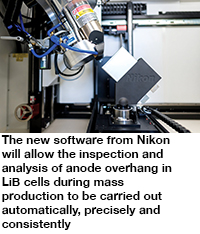Artificial intelligence speeds up automated battery anode overhang analysis using X-ray CT
03/04/2023
Inspection and analysis of anode overhang in lithium-ion battery (LiB) cells may be carried out automatically, precisely and consistently using 3D X-ray scanning and computed tomography (CT) during their mass production, where short inspection cycle times are key. It follows the introduction of the LiB.Overhang Analysis software powered by artificial intelligence (AI) from the Industrial Metrology Business Unit of Nikon Corporation. 
The software enables high production yield to meet increasing market demand for batteries and results in fewer expensive warranty claims from users of electric vehicles, energy storage systems and other battery-powered equipment.
The aim of the LiB.Overhang Analysis software is to encourage more in-line inspection earlier in the manufacturing process to improve product quality. Nikon provides a total solution by combining this new analysis approach with its innovative microfocus X-ray source, rotating target and Half.Turn CT technologies.
The anode in a LiB cell is larger than the cathode to prevent lithium plating and possible dendrite formation, so there are passive areas on the anode known as overhang regions that are not opposed by corresponding areas of cathode. Their dimensions must consistently be within close limits, otherwise battery performance may be reduced and, in extreme cases, it may spontaneously combust. It is therefore critically important to analyse anode overhang.
The problem with carrying out this analysis using traditional 2D radiography inspection is that, although fast, it does not provide results that are sufficiently precise or repeatable, as it is extremely difficult to distinguish individual layers with a single cone-beam radiograph, especially when the sheets are not perfectly flat.
Automation of overhang analysis by 3D X-ray CT, which is relatively new to the market, eliminates all of the above difficulties. The LiB.Overhang Analysis software is fast enough to cope with the speed of production lines, as it is less sensitive to noise in 3D images acquired by high-speed scanning.
This is because Nikon’s advanced machine learning AI model is able to use prior information to identify and classify anode overhang features and flaws in cells, regardless of the presence of typical noise and scan artefacts. Such scan data could confuse conventional methods of analysis and produce erroneous results when trying to segment the anode and cathode layers automatically. Much slower scanning would be needed to generate a higher-quality image, compromising quality control (QC) productivity.
Written in-house specifically for the manufacturer’s own XT H-series of X-ray CT systems, the LiB.Overhang Analysis
software allows battery cells to be scanned quickly, accurately and reliably, either in-line or line-side in a factory. Nikon engineers fine-tune both the CT scanning parameters and the LiB.Overhang Analysis software set-up to optimise the inspection speed and repeatability of the system.
Anode overhangs are calculated automatically by Nikon’s new software for each layer in the anode/cathode stack, generating not a simple pass/fail result but instead numerical measurements of critical features, so customers can utilise the statistics most relevant to their needs. Either method allows assembly issues to be detected and quantified early so data can be fed back to optimise the production process, increasing throughput and reducing scrap. The inspection data can be stored in a manufacturing execution system database to allow full traceability of each individual cell, consistent with Quality 4.0 practices.
Other unique Nikon technologies play a crucial role in the success of this inspection application, without which the necessary high-speed data acquisition would not be possible. One is to harness the penetrating capability of the company’s powerful microfocus X-ray sources. Another is to opt for the unique Rotating.Target 2.0, which spins in order to swiftly dissipate the heat generated by the small spot of electrons impinging on the tungsten surface, again allowing higher power than is otherwise possible. Nikon’s Half.Turn CT may also be deployed, whereby instead of rotating the sample under investigation 360° during the X-ray cycle, it is only necessary to rotate it just over 180° to obtain sufficient data for an image of equivalent quality, doubling inspection efficiency.